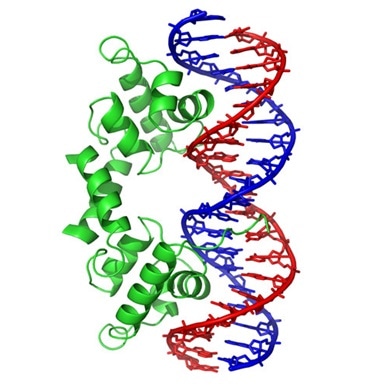Introduction
Deoxyribonucleic acid (DNA) has a unique structure and stability, making it an amazingly versatile molecule. This molecule plays a critical role in the biological world as it encodes and passes on all inheritable genetic information to subsequent generations.
However, DNA has also been extensively researched in fields that are beyond the usual scope of biology and standard genetics, from nano-electronics and nanotechnology through to optogenetics and drug delivery, leveraging its highly customizable properties.
In many of these studies, dynamic light scattering (DLS) determines the hydrodynamic size in microwell plates, cuvettes, or on-line, while the combination of multi-angle light scattering (MALS) and size exclusion chromatography (SEC-MALS) determines the absolute molar mass and size in solution. The following sections explain how light scattering is applied in the service of several novel DNA studies.
DNA: more than a genetic biomolecule
Aside from being a genetic biomolecule, DNA can also serve as a nano-technological tool. This capability was demonstrated by Mustafa et al. in their analysis of fluorescent emission from surface-functionalized nanoparticles that were controlled by single-stranded DNA (ssDNA) molecules (Mustafa B. et al. (2014). "DNA-length-dependent quenching of fluorescently labeled iron oxide nanoparticles with gold, graphene oxide and MoS2 nanostructures." ACS Appl. Mater. Interfaces 6:12100-10. doi: 10.1021/am503553h).
To verify the attachment and correlation to ssDNA length, the researchers used Wyatt’s DynaPro® NanoStar dynamic light scattering instrument to monitor the increased hydrodynamic radius Rh of the nanoparticle with the increasing length of ssDNA.
Based on the length of ssDNA, the degree of fluorescence quenching was adjusted which provided an understanding on how hybrid bio-nano-materials can be designed with tunable optical properties.
Antisense oligonucleotides
Antisense oligonucleotides (AONs) hold immense potential for therapeutic correction of various genetic diseases, but due to poor tissue uptake, the systemic use of AONs is rather limited.
A new class of AONs made of tricyclo-DNA (tcDNA) was presented by Goyenvalle et al. These AONs were designed as a conformationally-constrained oligonucleotide analogue (Goyenvalle A.et al. (2015) "Functional correction in mouse models of muscular dystrophy using exon-skipping tricyclo-DNA oligomers." Nat. Med. 21: 270-5. doi: 10.1038/nm.3765).
In addition to displaying exceptional pharmacological properties, this DNA variant shows unprecedented uptake by many tissues including the brain and the heart. This makes tcDNA-AON chemistry especially attractive as a promising therapy for neuromuscular disorders, including Duchenne muscular dystrophy.
The mechanism behind the improved pharmacologic performance was elucidated by SEC-MALS studies utilizing Wyatt’s Optilab® and DAWN® HELEOS® II. This indicated that tcDNA spontaneously forms nanoparticles that are well-defined and range from 40 to 100 nm (rms radius, Rg) in size.
Supported by MALS, electron microscopy, and nano-tracking analysis (NTA), this self-associative property mimics the features of nanoparticle delivery systems and transfection reagents that generally display good cellular uptake.
Optogenetics
Optogenetics is another interesting development utilizing DNA. Optogenetics is a biological method in which light is used to control cells in living tissues, including neurons. The synthetic optogenetic tools enable precise spatiotemporal control of biological processes and their design has developed quickly over the last few years.
In a new publication, Heintz and Schlichting explained the complex mechanism of light-dependent DNA binding of the light-oxygen-voltage (LOV) transcription factor from the Phaeodactylum tricornutum diatom (algae) (Heintz and Schlichting (2016). "Blue light-induced LOV domain dimerization enhances the affinity of Aureochrome 1a for its target DNA sequence." eLife 5).
As one of several DNA-binding assays, a DAWN HELEOS used in SEC-MALS experiments showed a light-sensitive interaction between the DNA-binding domain and LOV, where the monomer-dimer equilibrium is shifted towards the increasing molecular weight on exposure to blue light.
With a recovery time constant on the order of hundreds of seconds, the effect is long enough to be viewed in SEC separations, whereas the equilibrium itself is fast and displays a shift in molar mass that is correlated to concentration across the eluting peak.
The unique combination of various functionalities of Aureos provides novel design strategies for molecular switches to control biological processes with unparalleled temporal and spatial precision.

Self-assembled nanostructures
The development of structural DNA nanotechnology is attributed to the increasing insight into DNA’s structure and functionality. In this nanotechnology, DNA encodes biological information and also functions as a polymeric, structural material.
Using its molecular recognition properties, the DNA’s molecule can be made to self-assemble into higher order structures with exceptional nano-biotechnology applications, ranging from nano-carriers to sensing and drug delivery vehicles.
A DynaPro dynamic light scattering detector together with atomic force microscopy (AFM) was utilized by Tang et al. to define the size distribution of the hydrodynamic radii and micellar core heights, respectively (Tang L. et al. (2014), “Enzymatic Polymerization of High Molecular Weight DNA Amphiphiles That Self-Assemble into Star-Like Micelles.”, Adv. Mater. 26:3050-54. doi: 10.1002/adma.201306049).
The DLS technique demonstrated an excellent agreement with dissipative particle dynamics simulations, thus reiterating the strength of light scattering in measuring particle size.
Conclusion
While DLS and MALS are routinely used for characterizing DNA and its interactions with DNA-binding proteins and other standard binding partners, Wyatt Technology is pleased to know that its light scattering instruments are helping to extend the frontiers of DNA-based nanotechnology and nanomedicine.
Acknowledgements
Produced from materials originally authored by Dr. Izhar Medalsy, Product Marketing Manager, Wyatt Technology Corp. available at https://www.wyatt.com/blogs/highlights-light-scattering-reveals-novel-applications-of-dna.html